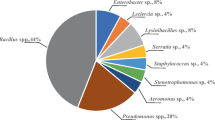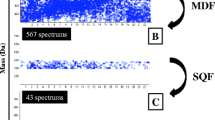Abstract
The anaerobic microbial degradation of aromatic and heterocyclic compounds is a prevalent process in contaminated groundwater systems. The introduction of functional groups into the contaminant molecules often results in aromatic and heterocyclic and succinic acids. These metabolites can be used as indicators for prevailing degradation processes. Therefore, there is a strong interest in developing analytical methods for screening and identification of these metabolites. In this study, neutral loss scans (NLS) by liquid chromatography-electrospray ionization/tandem mass spectrometry with losses of CO2 (NL ∆m/z = 44) and C2H4(CO2)2 (NL ∆m/z = 116) were applied for the first time successfully to screen selectively for acidic and succinic metabolites of aromatic and heterocyclic contaminants in two fulvic acid fractions from a contaminated site and a downstream region of a tar oil-polluted groundwater. Identification of these preselected signals was performed by high-resolution mass spectrometry with a liquid chromatography-electrospray ionization quadrupole time-of-flight mass spectrometry instrument. High-resolution mass and mass fragmentation data were then compared with a list of known metabolites from a literature search or matched with chemical databases supported with in silico fragmentation. Based on authentic analytical standards, several compounds from NLS were identified (e.g., 4-hydroxy-3-methylbenzoic acid, benzylsuccinic acid, naphthyl-2-methylsuccinic acid, 2-carboxyindane, and 2-carboxybenzothiophene) and tentatively identified (e.g., benzofuranmethylsuccinic acid and dihydrocarboxybenzothiophene) as aromatic, phenolic, heterocyclic, and succinic acids. The acidic metabolites were found exclusively in the contaminated region of the aquifer which indicates active biodegradation processes and no relevant occurrence of acidic metabolites in the downstream region.

ᅟ





Similar content being viewed by others
References
Luthy RG, Dzombak DA, Peters CA, Roy SB, Ramaswami A, Nakles DV, Nott BR (1994) Remediating tar-contaminated soils at manufactured gas plant sites. Environ Sci Technol 28:266A–276A
Meyer S, Cartellieri S, Steinhart H (1999) Simultaneous determination of PAHs, hetero-PAHs (N, S, O), and their degradation products in creosote contaminated soils. Method development, validation, and application to hazardous waste sites. Anal Chem 71:4023–4029
Vasilieva V, Scherr KE, Edelmann E, Hasinger M, Loibner AP (2012) Comprehensive GC2/MS for the monitoring of aromatic tar oil constituents during biodegradation in a historically contaminated soil. J Biotechnol 157:460–466
Sabljic A, Güsten H, Verhaar H, Hermens J (1995) QSAR modelling of soil sorption. Improvements and systematics of log KOC vs. log KOW correlations. Chemosphere 31:4489–4514
Hartnik T, Norli HR, Eggen T, Breedveld GD (2007) Bioassay-directed identification of toxic organic compounds in creosote contaminated groundwater. Chemosphere 66:435–443
Lovley DR (2001) Bioremediation: anaerobes to the rescue. Science 293:1444–1446
Beller H, Ding WH, Reinhard M (1995) Byproducts of anaerobic alkylbenzene metabolism useful as indicators of in situ bioremediation. Environ Sci Technol 29:2864–2870
Reineke W (2001) Aerobic and anaerobic degradation potentials of microorganisms. In: Beek B, Hutzinger KJ (eds) Biodegradation and persistence. The Handbook of environmental chemistry. Springer, Berlin, pp 1–161
Meckenstock RU, Safinowski M, Griebler C (2004) Mini review—anaerobic degradation of polycyclic aromatic hydrocarbons. FEMS Microbiol Ecol 49:27–36
Heider J (2007) Adding handles to unhandy substrates: anaerobic hydrocarbon activation mechanisms. Curr Opin Chem Biol 11:188–194
Foght J (2008) Anaerobic biodegradation of aromatic hydrocarbons: pathways and prospects. J Mol Microbiol Biotechnol 15:93–120
Krieger CJ, Beller HR, Reinhard M, Spormann AM (1999) Initial reactions in anaerobic oxidation of m-xylene by the denitrifying bacterium Azoarcus sp. strain T. J Bacteriol 181:6403–6410
Phelps CD, Young LY (2001) Biodegradation of BTEX under anaerobic conditions: a review. Adv Agron 70:329–357
Gieg L, Suflita J (2002) Detection of anaerobic metabolites of saturated and aromatic hydrocarbons in petroleum-contaminated aquifers. Environ Sci Technol 36:3755–3762
Safinowski M, Griebler C, Meckenstock RU (2006) Anaerobic cometabolic transformation of polycyclic and heterocyclic aromatic hydrocarbons: evidence from laboratory and field studies. Environ Sci Technol 40:4165–4173
Jobelius C, Ruth B, Griebler C, Meckenstock RU, Hollender J, Reineke A, Frimmel FH, Zwiener C (2011) Metabolites indicate hot spots of biodegradation and biogeochemical gradients in a high-resolution monitoring well. Environ Sci Technol 45:474–481
Beller HR (2000) Metabolic indicators for detecting in situ anaerobic alkylbenzene degradation. Biodegradation 11:125–139
Pico Y, Barcelo D (2008) The expanding role of LC-MS in analyzing metabolites and degradation products of food contaminants. Trends Anal Chem 27:821–835
Kern S, Fenner K, Singer HP, Schwarzenbach RP, Hollender J (2009) Identification of transformation products of organic contaminants in natural waters by computer-aided prediction and high-resolution mass spectrometry. Environ Sci Technol 43:7039–7046
Kosjek T, Heath E (2008) Applications of mass spectrometry to identifying pharmaceutical transformation products in water treatment. Trends Anal Chem 27:807–820
Ohlenbusch G, Zwiener C, Meckenstock RU, Frimmel FH (2002) Identification and quantification of polar naphthalene derivates in contaminated groundwater of a former gas plant site by liquid chromatography-electrospray ionisation tandem mass spectrometry. J Chromatogr A 967:201–207
Beller HR (2002) Analysis of benzylsuccinates in groundwater by liquid chromatography/ tandem mass spectrometry and its use for monitoring in situ BTEX biodegradation. Environ Sci Technol 36:2724–2728
Alumbaugh RE, Gieg LM, Field JA (2004) Determination of alkylbenzene metabolites in groundwater by solid-phase extraction and liquid chromatography-tandem mass spectrometry. J Chromatogr A 1042:89–97
García-Reyes JF, Hernando MD, Molina-Díaz A, Fernández-Alba AR (2007) Comprehensive screening of target, non-target and unknown pesticides in food by LC-TOF-MS. Trends Anal Chem 26:828–841
Hogenboom AC, van Leerdam JA, de Voogt P (2009) Accurate mass screening and identification of emerging contaminants in environmental samples by liquid chromatography-hybrid linear ion trap Orbitrap mass spectrometry. J Chromatogr A 1216:510–519
Krauss M, Singer H, Hollender J (2010) LC-high resolution MS in environmental analysis: from target screening to the identification of unknowns. Anal Bioanal Chem 397:943–951
Hernandez F, Sancho JV, Ibanez M, Abad E, Portoles T, Mattioli L (2012) Current use of high-resolution mass spectrometry in the environmental sciences. Anal Bioanal Chem 403:1251–1264
Aguera A, Martinez Bueno MJ, Fernandez-Alba AR (2013) New trends in the analytical determination of emerging contaminants and their transformation products in environmental waters. Environ Sci Pollut Res 20:3946–3515
Zwiener C, Frimmel FH (2004) LC-MS analysis in the aquatic environment and in water treatment—a critical review. Part I: instrumentation and general aspects of analysis and detection. Anal Bioanal Chem 378:851–861
Gentili A, Marchese S, Perret D (2008) MS techniques for analyzing phenols, their metabolites and transformation products of environmental interest. Trends Anal Chem 27:888–903
Zedda M, Zwiener C (2012) Is nontarget screening of emerging contaminants by LC-HRMS successful? A plea for compound libraries and computer tools. Anal Bioanal Chem 403:2493–2502
Neumann S, Böcker S (2010) Computational mass spectrometry for metabolomics: identification of metabolites and small molecules. Anal Bioanal Chem 398:2779–2788
Gerlich M, Neumann S (2013) MetFusion: integration of compound identification strategies. J Mass Spectrom 48:291–298
Wolf S, Schmidt S, Müller-Hannemann M, Neumann S (2010) In silico fragmentation for computer assisted identification of metabolite mass spectra. BMC Bioinforma 11:148–150
Kleineidam S, Rügner H, Ligouis B, Grathwohl P (1999) Organic matter facies and equilibrium sorption of phenanthrene. Environ Sci Technol 33:1637–1644
Frimmel FH, Abbt-Braun G, Heumann KG, Hock B, Lüdemann DD, Spiteller M (2002) Refractory organic substances in the environment. Wiley, Weinheim
Mantoura RFC, Riley JP (1975) The analytical concentration of humic substances from natural waters. Anal Chim Acta 76:97–106
Zwiener C, Kumke MU, Abbt-Braun G, Frimmel FH (1999) Adsorbed and bound residues in fulvic acid fractions of a contaminated groundwater—isolation, chromatographic and spectroscopic characterization. Acta Hydrochim Hydrobiol 27:208–213
Edler B, Zwiener C, Frimmel FH (1997) Particle beam LC/MS screening of polar compounds of contaminated groundwater samples from a former gas plant. Fresenius J Anal Chem 359:288–292
Zamfirescu D, Grathwohl P (1998) Schadstoffemission durch Desorption und Lösung standortspezifischer organischer Verbindungen im Schadenszentrum, Testfeld Süd. Grundwasser 4:167–174
Zwiener C, Frimmel FH (1998) Application of headspace GC/MS screening and general parameters for the analysis of polycyclic aromatic hydrocarbons in groundwater samples. Fresenius J Anal Chem 360:820–823
Müller MB, Zwiener C, Frimmel FH (1999) Sample cleanup and reversed-phase high-performance liquid chromatographic analysis of polar aromatic compounds in groundwater samples from a former gas plant. J Chromatogr A 862:137–145
Zamfirescu D, Grathwohl P (2001) Occurrence and attenuation of specific organic compounds in the groundwater plume at a former gasworks site. J Contam Hydrol 53:407–427
Kumke MU, Zwiener C, Abbt-Braun G, Frimmel FH (1999) Spectroscopic characterization of fulvic acid fractions of a contaminated groundwater. Acta Hydrochim Hydrobiol 27:409–415
Annweiler E, Materna A, Safinowski M, Kappler A, Richnow HH, Michaelis W, Meckenstock RU (2000) Anaerobic degradation of 2-methylnaphtalene by a sulfate-reducing enrichment culture. Appl Environ Microbiol 66:5329–5333
Kanehisa Laboratories (2013) http://www.genome.jp/kegg/. Accessed July 2013
National Center for Biotechnology Information (2013) http://pubchem.ncbi.nlm.nih.gov/. Accessed July 2013
Royal Society of Chemistry (2013) http://www.chemspider.com/. Accessed July 2013
Levsen K, Schiebel HM, Terlouw JK, Jobst KJ, Elend M, Preiß A, Thiele H, Ingendoh A (2007) Even-electron ions: a systematic study of the neutral species lost in the dissociation of quasi-molecular ions. J Mass Spectrom 42:1024–1044
McIntyre C, Batts BD, Jardine DR (1997) Electrospray mass spectrometry of groundwater organic acids. J Mass Spectrom JMS Lett 32:328–330
Plancque G, Amekraz B, Moulin V, Toulhoat P, Moulin C (2001) Molecular structure of fulvic acids by electrospray with quadrupole time-of-flight mass spectrometry. Rapid Commun Mass Spectrom 15:827–835
Reemtsma T, These A, Springer A, Linscheid M (2006) Fulvic acids as transition state of organic matter: Indications from high resolution mass spectrometry. Environ Sci Technol 40:5839–5845
Hertkorn N, Frommberger M, Witt M, Koch BP, Schmitt-Kopplin P, Perdue EM (2008) Natural organic matter and the event horizon of mass spectrometry. Anal Chem 80:8908–8919
Ibanez M, Sancho JV, Hernandez F, McMillan D, Rao R (2008) Rapid non-target screening of organic pollutants in water by ultraperformance liquid chromatography coupled to time-of-light mass spectrometry. Trends Anal Chem 27:481–489
Biegert T, Fuchs G, Heider J (1996) Evidence that anaerobic oxidation of toluene in the denitrifying bacterium Thauera aromatica is initiated by formation of benzylsuccinate from toluene and fumarate. Eur J Biochem 238:661–668
Griebler C, Safinowski M, Vieth A, Richnow HH, Meckenstock RU (2004) Combined application of stable carbon isotope analysis and specific metabolites determination for assessing in situ degradation of hydrocarbons in a tar-oil-contaminated aquifer. Environ Sci Technol 38:617–631
Annweiler E, Michaelis W, Meckenstock RU (2001) Anaerobic cometabolic conversion of benzothiophene by a sulfate-reducing enrichment culture and in a tar-oil-contaminated aquifer. Appl Environ Microbiol 67:5077–5083
Elshahed MS, Gieg LM, McInerney MJ, Suflita JM (2001) Signature metabolites attesting to the in situ attenuation of alkylbenzenes in anaerobic environments. Environ Sci Technol 35:682–689
Reusser DE, Istok JD, Beller HR, Field JA (2002) In situ transformation of deuterated toluene and xylene to benzylsuccinic acid analogues in BTEX-contaminated aquifers. Environ Sci Technol 36:4127–4134
Philipp B, Schink B (2012) Different strategies in anaerobic biodegradation of aromatic compounds: nitrate reducers versus strict anaerobes. Environ Microbiol Rep 4:469–478
Acknowledgments
This study was funded by the German Research Foundation (DFG) as part of the research group “Electron Transfer Processes in Anoxic Aquifers” (FOR 580). We thank Prof. Meckenstock for the availability of the synthesized standard naphthy-2-methylsuccinic acid and three anonymous reviewers for their helpful comments.
Author information
Authors and Affiliations
Corresponding author
Electronic supplementary material
Below is the link to the electronic supplementary material.
ESM 1
PDF 1,982 kb
Rights and permissions
About this article
Cite this article
Jobelius, C., Frimmel, F.H. & Zwiener, C. Mass spectrometric screening and identification of acidic metabolites in fulvic acid fractions of contaminated groundwater. Anal Bioanal Chem 406, 3415–3429 (2014). https://doi.org/10.1007/s00216-014-7783-y
Received:
Revised:
Accepted:
Published:
Issue Date:
DOI: https://doi.org/10.1007/s00216-014-7783-y




